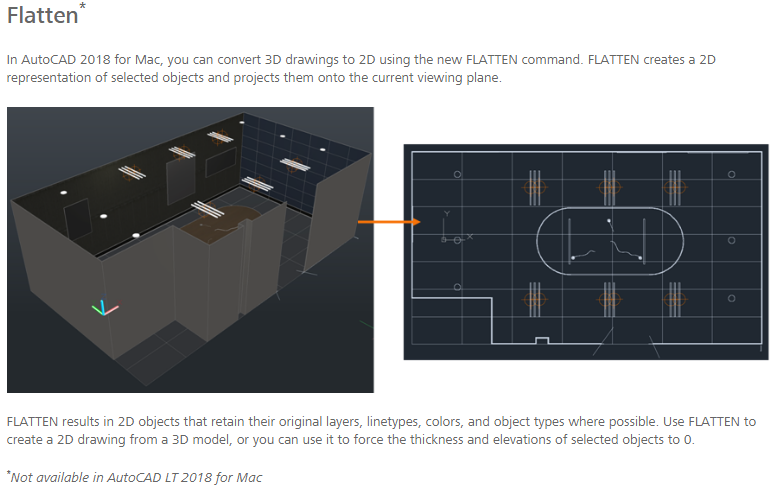Bricsys has just released BricsCAD V18 for Mac. Here’s the download link and here are the release notes.
BricsCAD V18 is an excellent DWG 2018-based CAD application, and the Mac version lacks little in comparison to the Windows version. It’s so much more capable than the perpetually half-baked AutoCAD for Mac that I struggle to comprehend why anybody with the choice would even contemplate the notably inferior and seriously overpriced Autodesk offering.
That’s not just opinion, it can be supported objectively.
Price first. US prices are shown here for a single standalone license over five years, inclusive of the cost of upgrades. The BricsCAD prices therefore include maintenance (it’s optional); the Autodesk prices are for subscription (not optional). No temporary discounts have been included. I have excluded bargain-basement BricsCAD Classic because it lacks the full set of programming and 3D modeling tools. I have assumed that there will be no price increases over the next five years. Given recent history, that’s probably close to the truth for Bricsys prices. Autodesk, not so much.
| Year | BricsCAD Pro | BricsCAD Platinum | AutoCAD |
| 1 | 970 | 1330 | 1470 |
| 2 | 240 | 240 | 1470 |
| 3 | 240 | 240 | 1470 |
| 4 | 240 | 240 | 1470 |
| 5 | 240 | 240 | 1470 |
| Total | 1930 | 2290 | 7350 |
It’s worth noting that if you want to stop paying Bricsys, you’re left with the latest version to use indefinitely. You can change your mind and get back on the upgrade train later, if you like. That sort of flexibility is long gone at Autodesk, where subscription means no pay, no play. If you stop paying, despite having paid 3.2 times as much for your software over the five year period, you’re left with nothing.
Now, features. You may have noticed that Autodesk is now too embarrassed to list the differences between the Windows and Mac versions of AutoCAD on its web site. The Compare AutoCAD vs. AutoCAD for Mac page is now a shadow of its former useful self, devoid of all detail. If you want to get a reasonable idea of what’s going on with AutoCAD for Mac’s deficiencies, you can check out my post about the 2017 release that lists the missing features.
Alternatively, you can have a look at the equivalent Bricsys comparison page, which you should probably do anyway before spending any money. It’s strange that you now need to visit a competitor’s page to get detailed information about an Autodesk product, but in the CAD world these are strange days indeed.
It’s important to note that the Bricsys comparison page has issues; while the BricsCAD columns are up to date, the AutoCAD columns are a year behind. That page definitely needs an update in order to provide a fair comparison. Don’t rely on it completely (e.g. all of the listed products except BricsCAD V17 for Linux use DWG 2018 as the native format, not DWG 2013), but it will give you an approximate idea. Look at the little red X marks in the rightmost column and you’ll see that a whole bunch of the missing AutoCAD for Mac features, even after all these years, are very significant and their absence could rule out the product for you. Don’t expect much in the way of future improvement. either. AutoCAD for Mac is in maintenance mode, just like the full product.
BricsCAD for Mac is not just more fully-featured, it’s ironically also more AutoCAD-compatible than Autodesk’s effort. For example, try to run a selection of LISP routines in both products. Almost all of it will run just fine in BricsCAD. Anything that uses ActiveX or DCL (dialog box) calls simply won’t work in AutoCAD. You might be all right with some simple routines (if it was written for AutoCAD for DOS then it will probably be fine) but any LISP even moderately sophisticated is going to fail.
BricsCAD for Mac doesn’t just provide capabilities that AutoCAD for Mac doesn’t have and never will, it offers something more than that. It offers a path beyond basic drafting. You can abandon all hope of Revit for Mac – that won’t be happening. AutoCAD-based vertical products? Nope. Inventor OS X? Forget it. But the availability of a product like Bricsys BIM for Mac (not priced above – it’s US$770 extra if purchased seperately) is an obvious drawcard for Mac-happy architects. You can create 3D parametric models on your Mac if you use BricsCAD Platinum, and you can create them without straying far from a familiar AutoCAD-like environment. Sheet metal? Sure (at extra cost).
If you’re a Mac-only person and you’re wedded to Autodesk, you’re not only being ripped off, you’re following a dead-end path. Time to check out the alternatives.

